Mastermind of The Bamako Terror Attack Mokhtar Belmokhtar: A CIA Sponsored “Intelligence Asset”? ~ once again folks , "who" IS behind em ??? ...
Both US and French intelligence are complicit in the State sponsorship of terrorism.
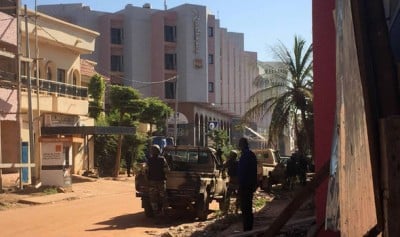
Five days later following the CIA Chief’s premonition, the Bamako Radisson Hotel Blu in Mali’s capital was the object of a terrorist attack, resulting in 21 people dead. Following the attack and the taking of hostages by the terrorists, French and Malian special forces raided the hotel. US. Africa Command (AFRICOM) also confirmed that US special forces were involved.
 The Bamako terror operation was allegedly coordinated by Mokhtar Belmokhtar (aka Khaled Abu al-Abbas), leader of an affiliate of Al Qaeda in the Islamic Maghreb (AQIM), the Islamist al-Mulathameen (Masked) Brigade, or “Those who Sign with Blood.”
The Bamako terror operation was allegedly coordinated by Mokhtar Belmokhtar (aka Khaled Abu al-Abbas), leader of an affiliate of Al Qaeda in the Islamic Maghreb (AQIM), the Islamist al-Mulathameen (Masked) Brigade, or “Those who Sign with Blood.”Belmokhtar’s group was created in 2012 in the wake of the war on Libya. His organization has also allegedly been involved in the drug trade, smuggling as well kidnapping operations of foreigners in North Africa. While his whereabouts are said to be known, French intelligence has dubbed Belmokhtar “the uncatchable”.
In June he was reported dead as a result in a U.S. air strike in Libya. His death was subsequently denied.
Based on shaky evidence, The New York Times report below (November 20) concludes that Belmokhtar’s group (together with AQIM) is unequivocally behind the Bamako attacks:
The SITE Intelligence Group is presented as an “independent” Washington think tank with a mandate of analyzing data pertaining to Al Qaeda affiliated terror organizations. SITE is also on contract with a number of US government agencies and has close links to US intelligence.A member of Al Qaeda in Africa confirmed Saturday that the attack Friday on a hotel in Bamako, Mali, had been carried out by a jihadist group loyal to Mokhtar Belmokhtar, an Algerian operative for Al Qaeda. The Qaeda member, who spoke via an online chat, said that an audio message and a similar written statement in which the group claimed responsibility for the attack were authentic. The SITE Intelligence Group, which monitors jihadist groups, also confirmed the authenticity of the statement.The Qaeda member, who refused to be named for his protection, said that Mr. Belmokhtar’s men had collaborated with the Saharan Emirate of Al Qaeda in the Islamic Maghreb, … In the audio recording, the group, known as Al Mourabitoun, says it carried out the operation in conjunction with Al Qaeda’s branch in the Islamic Maghreb.The recording was released to the Al Jazeera network and simultaneously to Al Akhbar, … The recording states: “We, in the group of the Mourabitoun [Arabic Rebel Group], in cooperation with our brothers in Al Qaeda in Islamic Maghreb, the great desert area, claim responsibility for the hostage-taking operation in the Radisson hotel in Bamako.” (emphasis added)
SITE has provided no substantive evidence which supports the authenticity of the online audio chat recording, which is considered as a reliable source. The story could have been planted.
Following the audio release, the Western media in chorus immediately pointed to an act of revenge directed against the French Republic in response to France’s 2013 military intervention in Mali, which had been ordered by President Francois Hollande.
“France saved Mali from al-Qaeda but it never broke terror threat”. “France saved northern Mali from al-Qaeda’s brutal rule … But the country is still beholden to outsiders and, as events at the Radisson hotel have demonstrated, acutely vulnerable to the worst of terrorism” (The Independent, November 20, 2015)
Screenshot The Independent, November 20, 2015
In turn, the French Minister of Defense acknowledged –prior to the
conduct of a police investigation– that the authors of the attack were
“most likely” led by Mokhtar Belmokhtar’s group in association with Al
Qaeda in the Islamic Maghreb (AQIM).What Defense Minister Jean-Yves Le Drain failed to mention was that both Belmokhtar and AQIM have longstanding links to the CIA, which in turn has a working relationship with France’s General Directorate for External Security, Direction générale de la sécurité extérieure (DGSE).
Casually ignored by the Western media, the leaders of Al Qaeda in the Islamic Maghreb (AQIM) including Belmokhtar were trained and recruited by the CIA in Afghanistan. Acknowledged by the Washington based Council on Foreign Relations (CFR):
Most of AQIM’s major leaders are believed to have trained in Afghanistan during the 1979-1989 war against the Soviets as part of a group of North African volunteers known as “Afghan Arabs” that returned to the region and radicalized Islamist movements in the years that followed. The group is divided into “katibas” or brigades, which are clustered into different and often independent cells.
The group’s top leader, or emir, since 2004 has been Abdelmalek Droukdel, also known as Abou Mossab Abdelwadoud, a trained engineer and explosives expert who has fought in Afghanistan and has roots with the GIA in Algeria. (Council on Foreign Relations, Al Qaeda in the Islamic Maghreb, cfr.org, undated)
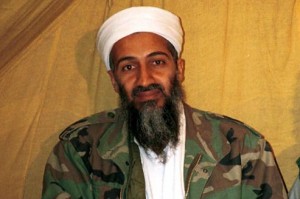 Saudi born terror mastermind Osama bin Laden
was recruited in 1979 ironically under the auspices of the CIA. The
training, recruitment and indoctrination of Mujahideen launched in 1979
was considered to be “the largest covert operation in the history of the
CIA” in response the Soviet Union’s military support of the
pro-Communist secular Afghan government of Babrak Kamal.
Saudi born terror mastermind Osama bin Laden
was recruited in 1979 ironically under the auspices of the CIA. The
training, recruitment and indoctrination of Mujahideen launched in 1979
was considered to be “the largest covert operation in the history of the
CIA” in response the Soviet Union’s military support of the
pro-Communist secular Afghan government of Babrak Kamal.Al Qaeda in Arabic means “the Base”. What it referred to was the CIA’s “Database” of Mujahideen recruits who were referred to by President Ronald Reagan as “freedom fighters”:
Shortly before his untimely death, former British Foreign Secretary Robin Cook told the House of Commons that “Al Qaeda” is not really a terrorist group but a database of international mujaheddin and arms smugglers used by the CIA and Saudis to funnel guerrillas, arms, and money into Soviet-occupied Afghanistan. (See Pierre-Henri Bunel, Al Qaeda: The Database, Global Research, November 20, 2005, emphasis added)Mokhtar Belmokhtar: Post Cold War CIA intelligence asset?
The Council on Foreign Relations erroneously describes “Mokhtar Belmokhtar as the one-eyed veteran of the anti-Soviet Afghan insurgency.” (CFR, op cit, emphasis added). Belmokhtar (born in 1972) did not fight in the Soviet-Afghan war (1979-1989). He was recruited in 1991 at the age of 19 in the immediate wake of the Cold War.
CIA recruitment continued in the wake of the Cold War. It was in large part directed against the Russian Federation and the former Soviet Republics as well as the Middle East.
The purpose of this later CIA recruitment was to establish a network of “intelligence assets” to be used in the CIA’s post-cold war insurgencies. Leaders of the Chechen Islamist insurgencies were also trained in CIA camps in Afghanistan and Pakistan, including the notorious leader of the Chechen insurrection Ibn al-Khattab (a citizen of Saudi Arabia).
 Following his training and recruitment and a two year stint in Afghanistan (1991-1993), Mokhtar Belmokhtar was sent back to Algeria in 1993 at age 21 where he joined the Salafist Group for Preaching and Combat (GSPC) (emblem left). The latter was initially part of the so-called Armed Islamic Group (Groupe islamique armé (GIA)) in
Algeria which sought to overthrow the secular Algerian Government with a
view to installing a theocratic Islamic State.
Following his training and recruitment and a two year stint in Afghanistan (1991-1993), Mokhtar Belmokhtar was sent back to Algeria in 1993 at age 21 where he joined the Salafist Group for Preaching and Combat (GSPC) (emblem left). The latter was initially part of the so-called Armed Islamic Group (Groupe islamique armé (GIA)) in
Algeria which sought to overthrow the secular Algerian Government with a
view to installing a theocratic Islamic State.Supported covertly by the CIA, Belmokhtar fought in Southern Algeria in the civil war opposing Islamist forces and the secular government. He was also instrumental in the integration and merging of “jihadist” forces.
In January 2007, the Armed islamic Group (GIA) which had been prominent in the 1990s, officially changed its name to the Al-Qaeda Organization in the Islamic Maghreb (AQIM).
In turn, as of 2007, the newly formed AQIM established a close relationship with the Libya Islamic Fighting Group (LIFG), which was directly supported by NATO during the 2011 war on Libya, “providing weapons, training, special forces and even aircraft to support them in the overthrow of Libya’s government.” (Tony Cartalucci, The Geopolitical Reordering of Africa: US Covert Support to Al Qaeda in Northern Mali, France “Comes to the Rescue”, Global Research, January 2013).
British SAS Special Forces had also been brought into Libya prior to the onset of the insurrection, acting as military advisers to the LIFG.
In fact, what has unfolded since the war on Libya is the merging of LIFG and AQIM forces. In turn, many of the LIFG operatives have been dispatched to Syria to fight within the ranks of Al Nusrah and the ISIS.
Robert Stephen Ford, US Ambassador to Algeria (2006-2008)
It is worth noting that the 2007 restructuring of jihadist forces in Algeria and the Maghreb coincided with the appointment of Robert Stephen Ford as US ambassador to Algeria in August 2006. Ford had been reassigned by the State Department from Baghdad to Algiers. From 2004 to 2006, he worked closely with Ambassador John Negroponte at the US embassy in Baghdad in supporting the creation of both Shia and Sunni death squads in Iraq.
This project consisted in recruiting and training terrorists modelled on the so-called “Salvador Option” which had been applied by the CIA in Central America. Negroponte as we recall played a central role in supporting the Contras terrorists in Nicaragua as ambassador to Honduras from 1981-1985. For further details see Michel Chossudovsky, “The Salvador Option For Syria”: US-NATO Sponsored Death Squads Integrate “Opposition Forces”, Global Research, May 28, 2012)
The 2006 appointment of Robert Stephen Ford to head the US Embassy in Algeria was timely. It coincided with the consolidation of jihadist groups within Algeria and the Maghreb. It preceded the 2011 US-NATO sponsored insurrections in Libya and Syria.
In 2010, Ford was approved by the US Congress as US Ambassador to Syria. He presented his credentials to president Bashar al Assad in January 2011, barely two months prior to the onslaught of the terrorist insurrection in the border city of Daraa in mid-March 2011. Ford played a central role in assisting the channelling of US and allied support to Syrian “opposition” groups including Al Nusrah and the ISIS.
Concluding Remarks
Belmokhtar’s history and involvement in
Afghanistan confirms that from the very outset he was an instrument of
US intelligence. While, he operates with a certain degree of
independence and autonomy in relation to his intelligence sponsors, he
and his organization are bona fide CIA “intelligence assets”, which can
be used by the CIA as part of a covert agenda.
There are various definitions of an “intelligence asset”. From the
standpoint of US intelligence, “assets” linked up to terrorist
organizations must not be aware that they are supported and monitored by
Western intelligence.
With regard to Al Qaeda, from the outset in 1979, the CIA chose to
operate through various front organizations as well as indirectly
through its Saudi, Qatari and Pakistani intelligence partners. CIA’s
Milton Beardman who played a central role in the Soviet Afghan war
confirms that members of Al Qaeda including Osama bin Laden were not
aware of the role they were playing on behalf of Washington. In the
words of bin Laden (quoted by Beardman): “neither I, nor my brothers saw
evidence of American help”(Michel Chossudovsky, Who is Osama bin Laden, Global Research, September 12, 2001):
Amply documented, Al Qaeda in the Islamic Maghreb (AQIM)and its affiliated groups including the Libya Islamic Fighting Group (LIFG) was serving the interests of the Western military alliance. Confirmed by the Washington Post, June 29, 2011 (See below), France was supplying weapons to the LIFG at the height of NATO’s bombing raids.Motivated by nationalism and religious fervor, the Islamic warriors were unaware that they were fighting the Soviet Army on behalf of Uncle Sam. While there were contacts at the upper levels of the intelligence hierarchy, Islamic rebel leaders in theatre had no contacts with Washington or the CIA. (Ibid)
AQIM in turn was receiving weapons from the LIFG, which was supported by NATO. Moreover, LIFG mercenaries had integrated AQIM brigades.
According to alleged Terror Mastermind Mokhtar Belmokhtar, who also coordinated the 2013 In Amenas Mali kidnapping operation:
“We have been one of the main beneficiaries of the revolutions in the Arab world. As for our benefiting from the (Libyan) weapons, this is a natural thing in these kinds of circumstances.” http://www.hanford.gov/c.cfm/oci/ci_terrorist.cfm?dossier=174
Al Qaeda in the Islamic Maghreb (AQIM) is indelibly tied into a Western intelligence agenda. While it is described as ”one of the region’s wealthiest, best-armed militant groups”, financed covertly by Saudi Arabia and Qatar. France’s Canard enchaîné revealed (June 2012) that Qatar (a staunch ally of the United States) has been funding various terrorist entities in Mali:
The original report cites a French military intelligence report as indicating that Qatar has provided financial support to all three of the main armed groups in northern Mali: Iyad Ag Ghali’s Ansar Ed-Dine, al-Qa’ida in the Islamic Maghreb (AQIM) and the Movement for Unity and Jihad in West Africa (MUJWA).
The amount of funding given to each of the groups is not mentioned but it mentions that repeated reports from the French DGSE to the Defense Ministry have mentioned Qatar’s support for ‘terrorism’ in northern Mali. (quoted by Jeune Afrique June 2012)
Qatar is a proxy state, a de facto Persian Gulf territory largely
controlled by Washington. It hosts a number of Western military and
intelligence facilities.
The Emir of Qatar does not finance terrorism without the consent of the CIA.
And with regard to Mali, the CIA coordinates its activities in liaison with its French intelligence partners and counterparts, including la Direction du renseignement militaire (DRM) and the Direction générale de la sécurité extérieure (DGSE).
The implications are obvious and should be carefully understood by Western public opinion. Inasmuch as Belmokhtar and AQIM are “intelligence assets”, both US and French intelligence are (indirectly) behind the Bamako attacks.
Both US and French intelligence are complicit in the State sponsorship of terrorism.
The Emir of Qatar does not finance terrorism without the consent of the CIA.
And with regard to Mali, the CIA coordinates its activities in liaison with its French intelligence partners and counterparts, including la Direction du renseignement militaire (DRM) and the Direction générale de la sécurité extérieure (DGSE).
The implications are obvious and should be carefully understood by Western public opinion. Inasmuch as Belmokhtar and AQIM are “intelligence assets”, both US and French intelligence are (indirectly) behind the Bamako attacks.
Both US and French intelligence are complicit in the State sponsorship of terrorism.
The original source of this article is Global Research
Copyright © Prof Michel Chossudovsky, Global Research, 2015
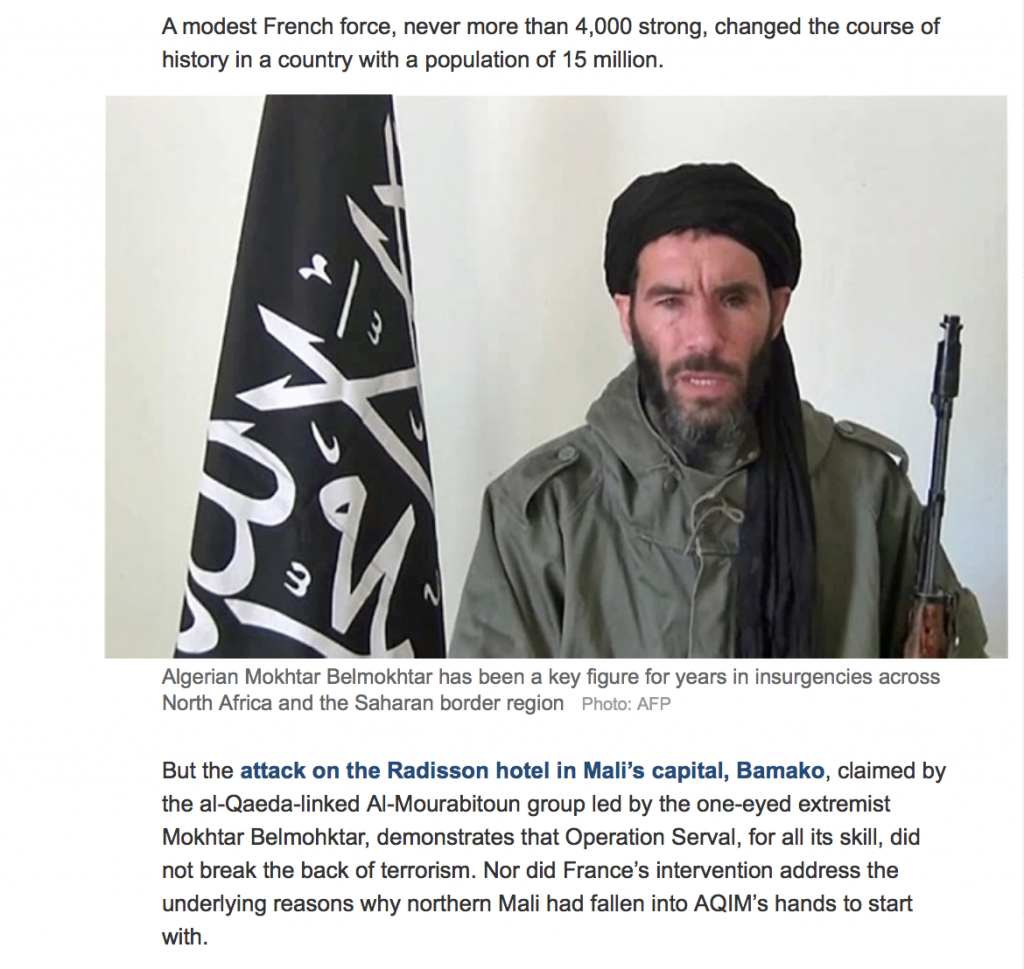
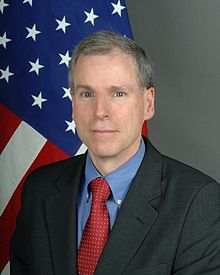
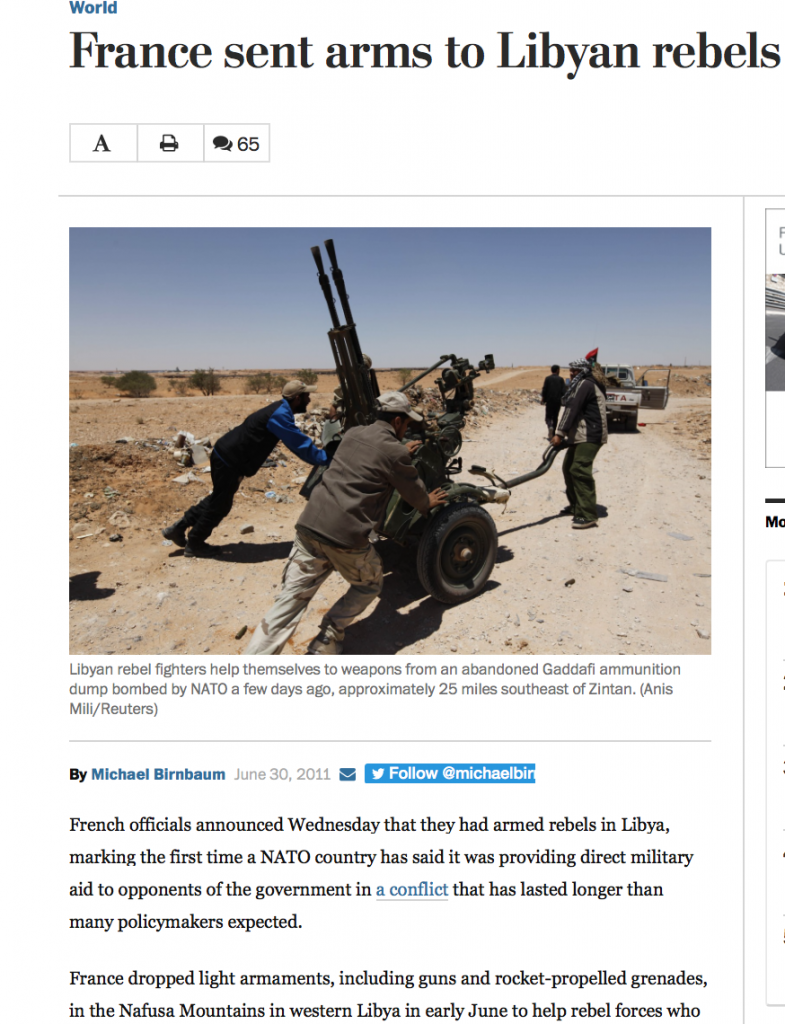
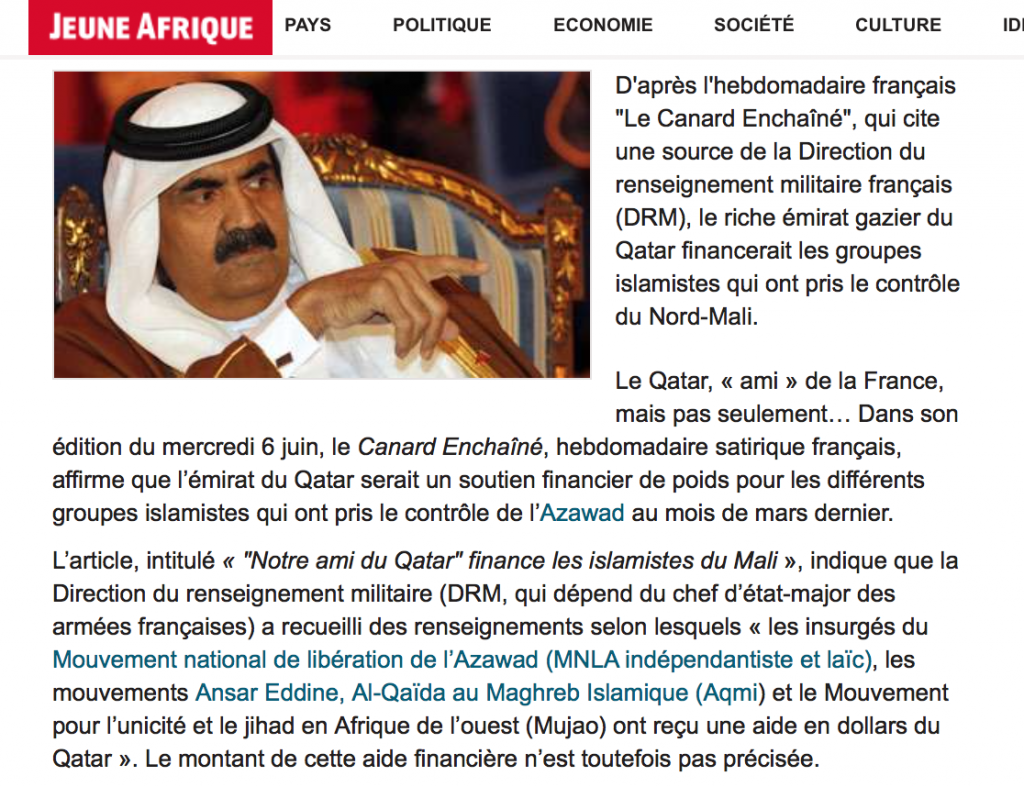
No comments:
Post a Comment